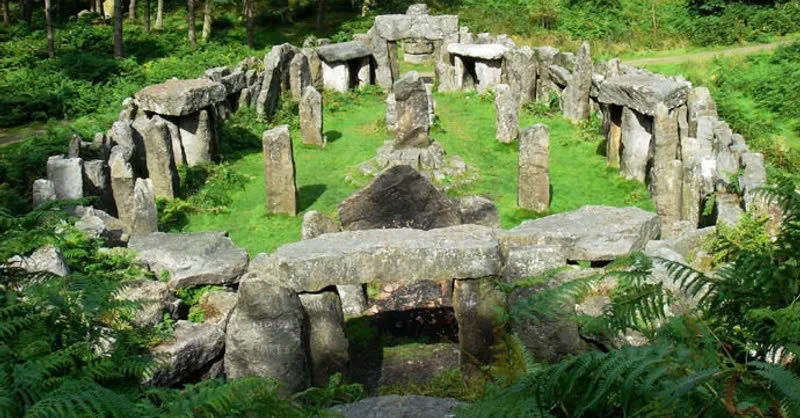In the somber aftermath of the Napoleonic Wars, Yorkshire grappled with a severe economic depression that left many workers unemployed and struggling to survive. Amid this challenging time, William Danby, a wealthy and eccentric country squire, emerged with a unique vision that aimed to alleviate local unemployment while creating an enduring architectural marvel that would captivate generations.
The Birth of a Remarkable Folly and an Unconventional Solution
William Danby, known as a former Sheriff of Yorkshire and a landowner with considerable wealth, sought to tackle the widespread economic distress in an unconventional way. Rather than offering traditional charity or assistance, he devised a bold and creative plan. Danby proposed the construction of an extraordinary structure: a stone circle inspired by ancient monuments such as Stonehenge. This ambitious project would serve not only as an employment initiative but also as a testament to human creativity and resourcefulness.

To bring this vision to life, Danby hired unemployed workers and paid them one shilling per day—a meaningful wage at the time. By doing so, he provided a much-needed source of income to those in need while engaging them in a project that blended artistry, history, and labor. This endeavor was as much a social experiment as it was an architectural feat, designed to foster a sense of purpose and dignity among the local workforce.
Architectural Wonders: The Temple’s Design
The structure that emerged from Danby’s imagination became known as the Druids Temple, an installation of striking proportions and symbolic significance. Constructed with towering standing stones, some reaching an impressive height of 10 feet, the temple was arranged in a circular layout spanning 100 feet in diameter. At the center of this formation lay a modest yet compelling stone altar, surrounded by carefully positioned monoliths that seemed to evoke a sense of ancient ritual and mystery.
Beyond the stone circle, the temple’s design incorporated additional elements that heightened its allure. A cave-like tomb and a circular chamber added layers of intrigue, offering visitors a glimpse into an environment that felt both timeless and otherworldly. These features, though fabricated in the 19th century, imbued the site with an air of antiquity and sparked curiosity about its purpose and origins.
The Hermit’s Unusual Role and the Strange Experiment
Adding another layer of eccentricity to the project, William Danby introduced a bizarre element to the Druids Temple—an experiment involving a hermit. Danby recruited an individual to live within the tomb on the grounds of the temple under strict conditions. The hermit was required to maintain complete silence, refrain from personal grooming, and embrace an unkempt appearance, embodying the stereotype of a solitary mystic.
This peculiar arrangement was meant to heighten the mystique of the temple, attracting further interest and speculation. However, the experiment proved to be unsustainable, lasting only four years. Rumors circulated that the hermit’s mental health deteriorated during his time in isolation, underscoring the psychological toll of such a restrictive and solitary existence.
Legends and the Aura of Mystery Surrounding the Temple
Over the decades, the Druids Temple has become the subject of numerous legends and whispers of the supernatural. Visitors and locals alike have shared chilling accounts of unusual phenomena that seem to defy explanation. Among the reported occurrences are disembodied shadows gliding across the stone surfaces, eerie noises echoing through the site, and inexplicable feelings of unease that seem to grip those who wander too close to the altar.
One particularly infamous incident occurred around the year 2000, when a pig’s head was discovered on the altar. This unsettling discovery fueled suspicions of occult activity, prompting discussions in the House of Lords. Baroness Masham notably expressed concern about the potential for satanic rituals to be conducted at the site, further deepening the temple’s enigmatic reputation.
A Sanctuary for the Modern Era
Despite its mysterious past and supernatural tales, the Druids Temple has evolved into a serene destination that draws visitors seeking beauty, history, and tranquility. Today, it serves as a stunning woodland retreat, offering clearly marked pathways for leisurely exploration and a nearby café for refreshments. The site’s atmosphere has shifted from one of provocation and experimentation to one of peace and reflection, allowing visitors to appreciate its architectural splendor and imaginative origins.
For those who visit, the temple provides not only a glimpse into a fascinating chapter of Yorkshire’s history but also an opportunity to marvel at the ingenuity and compassion that shaped its creation. The woodland surrounding the temple enhances its charm, creating an immersive experience that transports visitors to another time and place.
A Legacy of Creativity and Compassion
William Danby’s 19th-century folly endures as more than just a collection of stones; it stands as a testament to the power of human creativity and the extraordinary measures taken to support a community in need. By envisioning and funding such an ambitious project, Danby demonstrated how art and architecture could serve as tools for both economic relief and cultural enrichment.
The Druids Temple remains a captivating blend of historical curiosity, architectural wonder, and enduring mystery. It is a site that invites exploration, reflection, and imagination, offering a profound connection to the past while inspiring awe in the present. As a jewel of Yorkshire’s landscape, it continues to remind us of the boundless potential of human ingenuity, even in the face of adversity.





